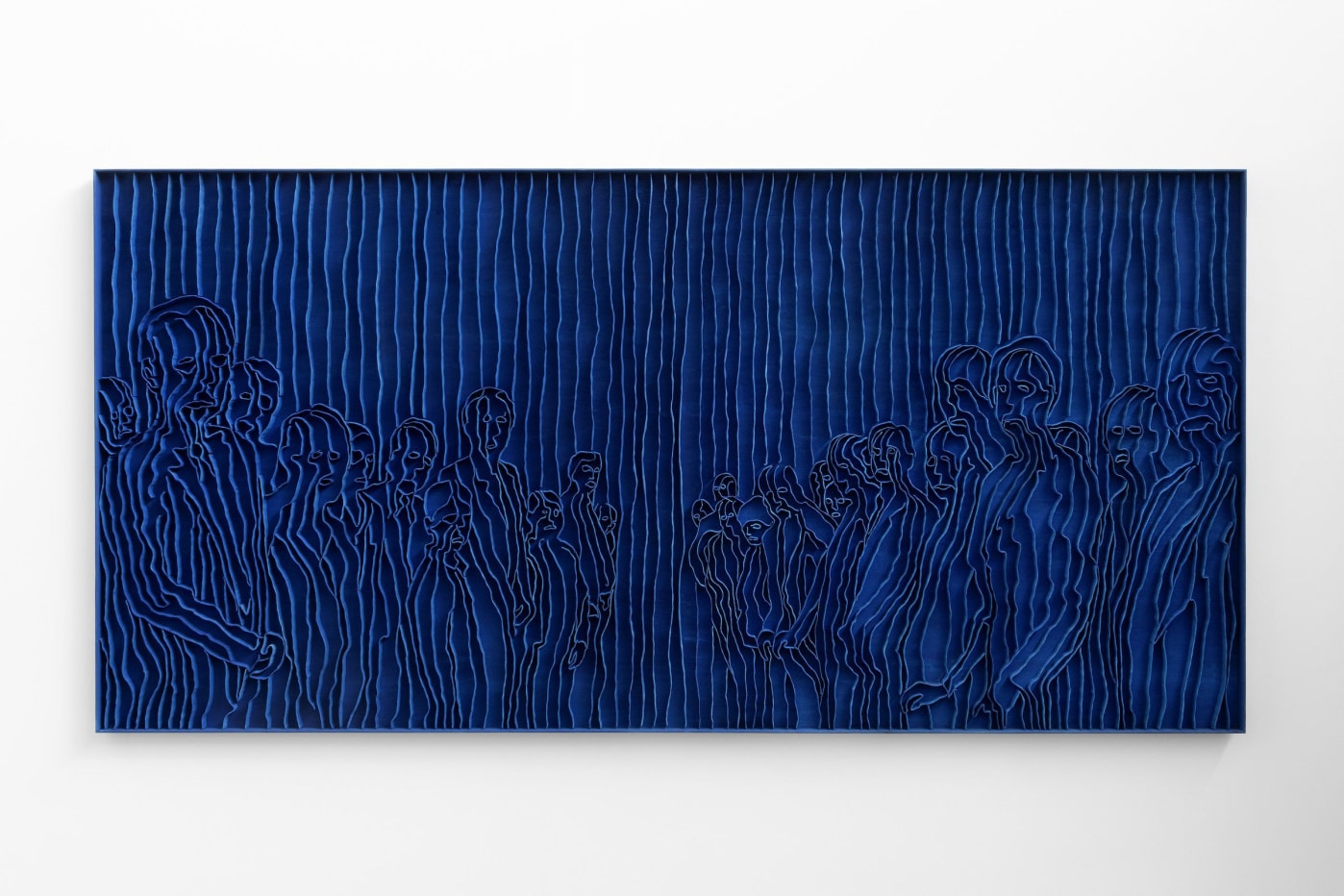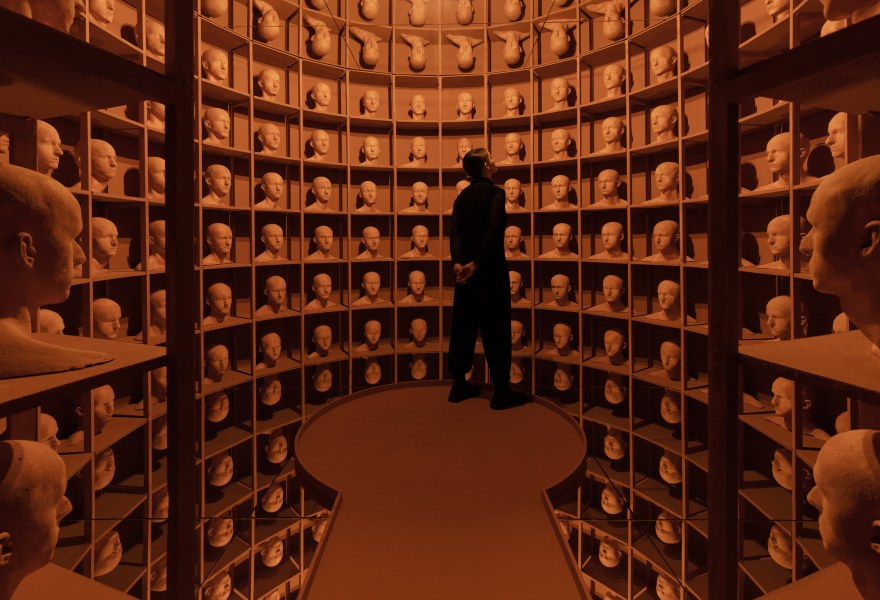20 march 2023, Wouter van den Eijkel
In the depths of memory – Levi van Veluw
For In the depths of memory, Levi van Veluw returned to his more autobiographical approach of ten years ago to create a series of three-dimensional wall sculptures about memories and their deceptive inaccuracy. Also included are a film and amazing infinity room in which Van Veluw presents the viewer with a fever dream in which he has to keep creating as an artist.
Ask someone what they ate last night and chances are they'll have to think about it for a moment. When it comes to everyday activities like eating dinner, we do not register every detail. We rely on countless half-memories. The same goes for people we once met. We know we’ve met them, but a good recollection of the person’s face is no possible. What remains is an impression, often combined with later memories or films seen in the meantime.

Levi van Veluw, Abstruse, 2023, Galerie Ron Mandos
This problematic side of memories immediately raises questions such as: are you still the same person you were back then and how do you actually translate such a fragmented memory into a work? These are the questions Levi van Veluw explores in In the depths of memory. The point of departure is his previous show in which religion and religious architecture – executed in blue, marbled clay – were the central theme. To clarify this, a number of works from that series are also on display at Galerie Ron Mandos. Although the subject was a personal one for him, it was fairly abstract in terms of execution. In turn, this gave Van Veluw the idea to return in this series to his more autobiographical approach of ten years ago, work in which his self-portrait played a major role.
Van Veluw explains, “I wanted to do something with these self-portraits again, but in a completely different way. Instead of showing the exterior, I tried to show the interior. This self-portrait is a kind of reminder of how you saw or see yourself, hence the jagged lines. I don't try to capture the face as best as possible in terms of shape, but instead represent a certain state of mind by letting all those lines flow through the head.”
Van Veluw began with drawings and ended up with wooden sculptures because the lines of are less easy for the eye to follow and always produce a different image due to the changing light. “A line on paper is easy to follow, but a wooden line is much harder to follow, since it has depth and changes continuously with the changing light. That was also my approach to this series, to make works that are about memories or something originating from memory that is associated to some degree with truthfulness. But since it is an interpretation and therefore subjective, it changes over time. I thought that was an exciting idea.”

Levi van Veluw, Exposure, 2023, Galerie Ron Mandos
The scenes created by Van Veluw as three-dimensional wood sculptures are fairly common. They also have titles that are more descriptive than personal. For example, the work about riding in the back seat of your parents’ car is called In Between, a table setting is called Dinner and a church scene with rows of churchgoers looking at you from both sides of the aisle is called Exposure. The churchgoers have turned and are looking downwards. Their faces are not shown in detail, but the expressions are recognisable. It's a child's perspective. “These are specific memories for me, but the viewer doesn’t need to know that because it is important to me that viewers can project their own experience onto them. I have deliberately left them suggestive.”

Levi van Veluw, Dinner, 2023, Galerie Ron Mandos
At the opening of In the depths of memory, art consultant Jeannette ten Kate of The Art Connector praised the conceptual aspects and execution of Van Veluw's work. “With Levi, the format is the artwork and that format is executed brilliantly every time. It is an approach that is consistently developed and rolled out further.”
Ten Kate’s retelling of this consistent execution goes all the way back to Van Veluw's graduation project. “When he graduated, he used his own face as the canvas, drawing on it with pen and pasting over. He then took pictures himself and it was clear that Levi was the subject. What do those adjustments do to the perception of people looking at him? The memory theme later became part of his work and his family started to play a role. He also began producing larger work, such as massive rooms and installations made entirely with blocks, balls and videos.”

Levi van Veluw, In the depths of memory, 2023, Galerie Ron Mandos
Bam!
The highlight of In the depths of memory is the work of the same name that is found at the back of the gallery: a two-stage missile consisting of a film and purpose-built mirror room. In the film, we see Levi surrounded by shelving units full of busts of himself as he feverishly works on the next bust. The moment he puts the statue in an empty compartment in the cupboard and is about to walk away, another empty surface pops up and the dull thud of a falling lump of clay can be heard. Bam! Everything starts all over again.
Van Veluw comments, “The film is about the moment when you almost fall asleep. As an artist, you are always focusing on what you are about to make and at some point, you get into a flow. At such a moment, you are obsessively creating work. In the film, it has become a kind of loop. The more tired you get, the more that thought gets compressed into a very short repetition. A kind of fever dream.” In the adjacent mirror room, we take Levi's place and Van Veluw convincingly manages to convey restless, compulsive thought to the viewer with minimal means.
In the depths of memory by Levi van Veluw can be seen at Galerie Ron Mandos in Amsterdam until April 23

Levi van Veluw, In the depths of memory, 2023, Galerie Ron Mandos
